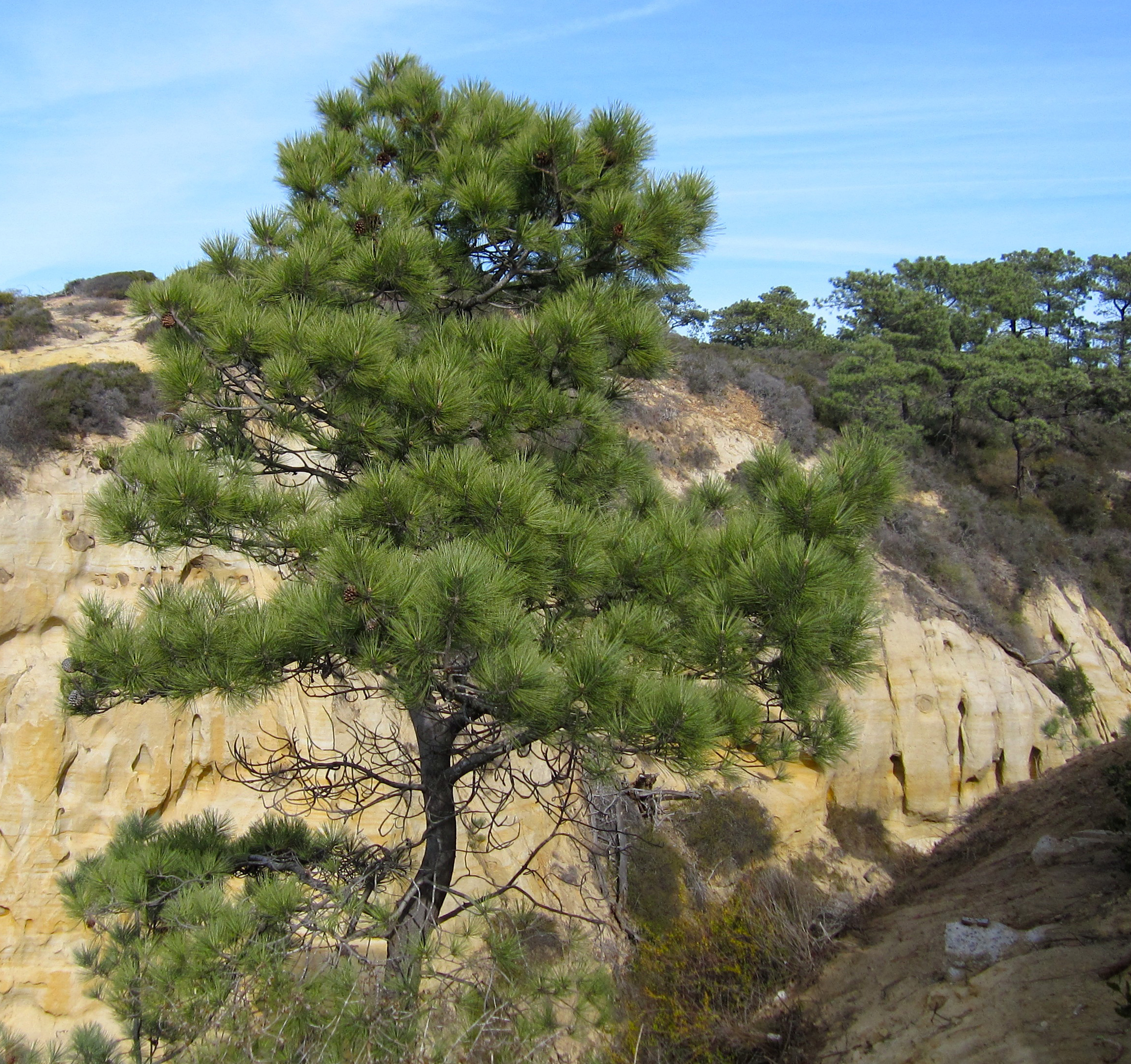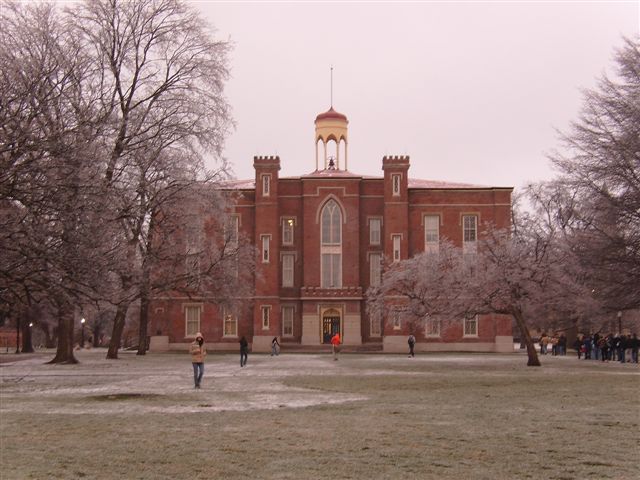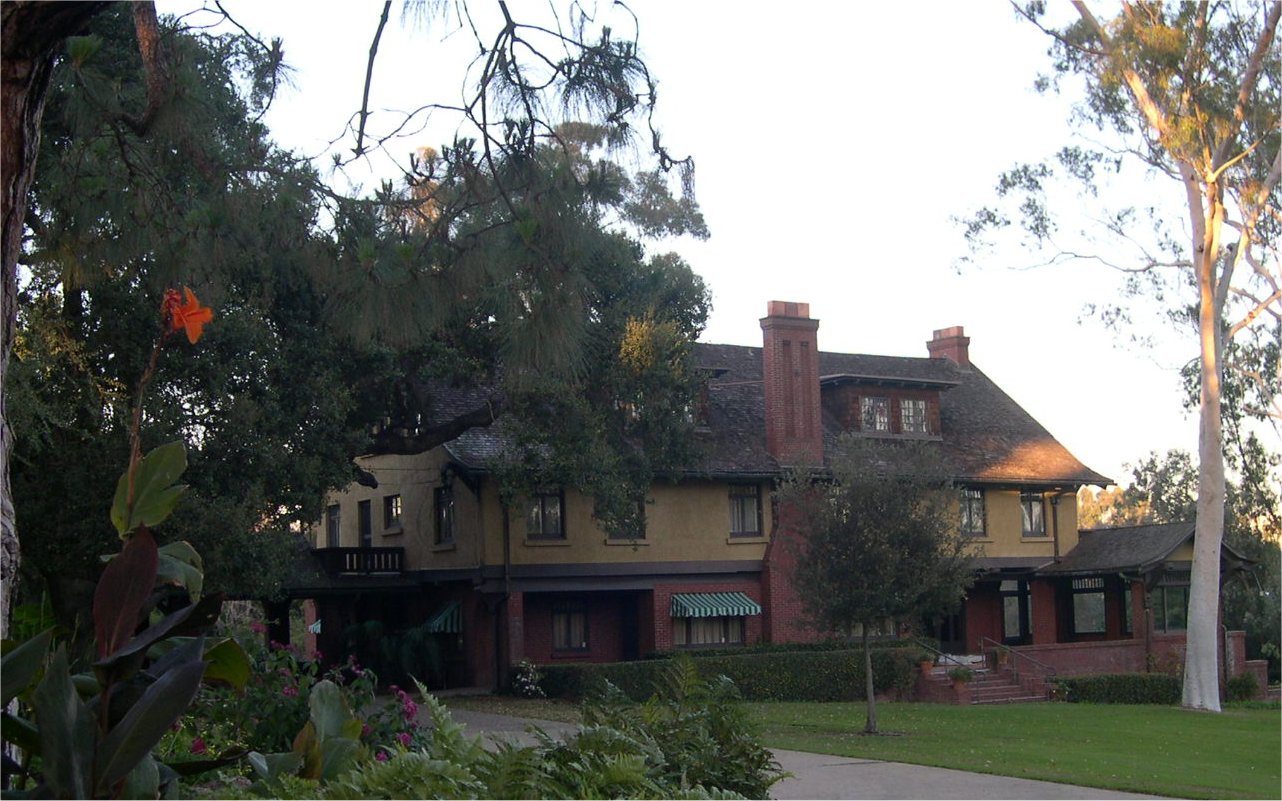|
Torrey Pines State Natural Reserve
Torrey Pines State Natural Reserve is of coastal state park located in the community of La Jolla, in San Diego, California, off North Torrey Pines Road. Although it is located within San Diego city limits, it remains one of the wildest stretches of land (8 km²) on the Southern California coast. It is bordered immediately on the south by Torrey Pines Municipal Golf Course and on the north by the city of Del Mar. The reserve was designated a National Natural Landmark in 1977. The reserve consists of a plateau with cliffs that overlook Torrey Pines State Beach, and a lagoon that is vital to migrating seabirds. Many different kinds of wildlife and flora are found within the reserve, including bobcat, fox, skunk, raccoon, coyote, rabbit, cacti, coastal chaparral, and the rare Torrey pine. During Whale migration, it is sometimes possible to see several species of whale from the cliffs, including humpback whale and gray whale. The of trails within the park offer an attr ... [...More Info...] [...Related Items...] OR: [Wikipedia] [Google] [Baidu] |
California
California is a U.S. state, state in the Western United States, located along the West Coast of the United States, Pacific Coast. With nearly 39.2million residents across a total area of approximately , it is the List of states and territories of the United States by population, most populous U.S. state and the List of U.S. states and territories by area, 3rd largest by area. It is also the most populated Administrative division, subnational entity in North America and the 34th most populous in the world. The Greater Los Angeles area and the San Francisco Bay Area are the nation's second and fifth most populous Statistical area (United States), urban regions respectively, with the former having more than 18.7million residents and the latter having over 9.6million. Sacramento, California, Sacramento is the state's capital, while Los Angeles is the List of largest California cities by population, most populous city in the state and the List of United States cities by population, ... [...More Info...] [...Related Items...] OR: [Wikipedia] [Google] [Baidu] |
Whale
Whales are a widely distributed and diverse group of fully aquatic placental marine mammals. As an informal and colloquial grouping, they correspond to large members of the infraorder Cetacea, i.e. all cetaceans apart from dolphins and porpoises. Dolphins and porpoises may be considered whales from a formal, cladistic perspective. Whales, dolphins and porpoises belong to the order Cetartiodactyla, which consists of even-toed ungulates. Their closest non-cetacean living relatives are the hippopotamuses, from which they and other cetaceans diverged about 54 million years ago. The two parvorders of whales, baleen whales (Mysticeti) and toothed whales (Odontoceti), are thought to have had their last common ancestor around 34 million years ago. Mysticetes include four extant (living) families: Balaenopteridae (the rorquals), Balaenidae (right whales), Cetotheriidae (the pygmy right whale), and Eschrichtiidae (the grey whale). Odontocetes include the Monodontidae (beluga ... [...More Info...] [...Related Items...] OR: [Wikipedia] [Google] [Baidu] |
Salt Marsh
A salt marsh or saltmarsh, also known as a coastal salt marsh or a tidal marsh, is a coastal ecosystem in the upper coastal intertidal zone between land and open saltwater or brackish water that is regularly flooded by the tides. It is dominated by dense stands of salt-tolerant plants such as herbs, grasses, or low shrubs. These plants are terrestrial in origin and are essential to the stability of the salt marsh in trapping and binding sediments. Salt marshes play a large role in the aquatic food web and the delivery of nutrients to coastal waters. They also support terrestrial animals and provide coastal protection. Salt marshes have historically been endangered by poorly implemented coastal management practices, with land reclaimed for human uses or polluted by upstream agriculture or other industrial coastal uses. Additionally, sea level rise caused by climate change is endangering other marshes, through erosion and submersion of otherwise tidal marshes. However, recent ackn ... [...More Info...] [...Related Items...] OR: [Wikipedia] [Google] [Baidu] |
Coastal Sage Scrub
Coastal sage scrub, also known as coastal scrub, CSS, or soft chaparral, is a low scrubland plant community of the California coastal sage and chaparral subecoregion, found in coastal California and northwestern coastal Baja California. It is within the California chaparral and woodlands ecoregion, of the Mediterranean forests, woodlands, and scrub biome. Characteristics ;Plant community Coastal sage scrub is characterized by low-growing aromatic, and drought-deciduous shrubs adapted to the semi-arid Mediterranean climate of the coastal lowlands. The community is sometimes called "soft chaparral" due to the predominance of soft, drought-deciduous leaves in contrast to the hard, waxy-cuticled leaves on sclerophyllous plants of California's chaparral communities. ;Flora Characteristic shrubs and subshrubs include: * California sagebrush (''Artemisia californica'') * Black sage (''Salvia mellifera'') * White sage (''Salvia apiana'') * California buckwheat (''Eriogonum fascicul ... [...More Info...] [...Related Items...] OR: [Wikipedia] [Google] [Baidu] |
Santa Ana Winds
The Santa Ana winds (sometimes devil winds) "Scholars who have looked into the name's origins generally agree that it derives from Santa Ana Canyon, the portal where the Santa Ana River -- as well as a congested Riverside (CA-91) Freeway -- leaves Riverside County and enters Orange County. When the Santa Anas blow, winds can reach exceptional speeds in this narrow gap between the Puente Hills and Santa Ana Mountains." are strong, extremely dry downslope winds that originate inland and affect coastal Southern California and northern Baja California. They originate from cool, dry high-pressure air masses in the Great Basin. Santa Ana winds are known for the hot, dry weather that they bring in autumn (often the hottest of the year), but they can also arise at other times of the year. They often bring the lowest relative humidities of the year to coastal Southern California, and “beautifully clear skies.” These low humidities, combined with the warm, compressionally-heated air ... [...More Info...] [...Related Items...] OR: [Wikipedia] [Google] [Baidu] |
Santa Rosa Island (California)
Santa Rosa Island (Spanish: ''Isla de Santa Rosa''; Chumash: ''Wi'ma'') is the second largest of the Channel Islands of California at 53,195 acres (215.27 km2 or 83.118 sq mi). Santa Rosa is located about off the coast of Santa Barbara, California in Santa Barbara County and is part of Channel Islands National Park. The Chumash, a Native American people lived on the Channel Islands at the time of European contact. The remains of a 13,000-year-old Arlington Springs Man, possibly the oldest human remains in the Americas, were discovered on the island in 1959. Santa Rosa Island is home to the rare Torrey Pine, a species of pine tree that exists only in two locations around the world. Geography The terrain consists of rolling hills, deep canyons, and a coastal lagoon. Highest peak is Vail Peak, at . During the last ice age, the four northern Channel Islands, including Santa Rosa Island, were conjoined into Santa Rosae, a single island that was only five miles (8 km ... [...More Info...] [...Related Items...] OR: [Wikipedia] [Google] [Baidu] |
Pinus Torreyana Torreyana
The Torrey pine (''Pinus torreyana'') is a rare pine species in California, United States. It is a critically endangered species growing only in coastal San Diego County, and on Santa Rosa Island, offshore from Santa Barbara in Santa Barbara County. The Torrey pine is endemic to the California coastal sage and chaparral ecoregion. Taxonomy The species epithet ''torreyana'' is named for John Torrey, an American botanist, after whom the coniferous genus ''Torreya'' is also named. Description ''Pinus torreyana'' is a broad, open-crowned pine tree growing to tall in the wild, with long leaves ('needles') in groups of five. The cones are stout and heavy, typically long and broad, and contain large, hard-shelled, but edible, pine nuts. Like all pines, its needles are clustered into ' fascicles' that have a particular number of needles for each pine species; in the Torrey pine there are five needles in each fascicle. Like all pines, it has strobili, structures that function as ... [...More Info...] [...Related Items...] OR: [Wikipedia] [Google] [Baidu] |
Guy Fleming
Guy L. Fleming (May 27, 1884 – May 15, 1960) was an American naturalist whose conservation work led to the founding of Torrey Pines State Natural Reserve, now a 2000-acre protected coastal area of La Jolla, San Diego. The Torrey pine, ''Pinus torreyana'', is the rarest pine species in the United States. As district superintendent of state parks for southern California, Fleming also worked to protect major nature preserves that extend from the U.S. border with Mexico to northern San Diego county; these include the natural areas that became Anza-Borrego Desert State Park, Cuyamaca Rancho State Park and Palomar Mountain State Park. As a fellow of the San Diego Society of Natural History, he worked closely with scientists and staff of the San Diego Natural History Museum, leading public nature walks for the museum and lecturing on environmental issues. Biography Born in Nebraska on May 27, 1884, to Georgia Lowd and James Fleming (a carpenter), Guy L. Fleming was twelve when his ... [...More Info...] [...Related Items...] OR: [Wikipedia] [Google] [Baidu] |
Ellen Browning Scripps
Ellen Browning Scripps (October 18, 1836 – August 3, 1932) was an American journalist and philanthropist who was the founding donor of several major institutions in Southern California. She and her half-brother E. W. Scripps created the E. W. Scripps Company, America's largest chain of newspapers, linking Midwestern industrial cities with booming towns in the West. By the 1920s, Ellen Browning Scripps was worth an estimated $30 million (or $388 million in 2020 dollars), most of which she gave away. In 1924, she founded the Scripps Research Institute (TSRI), in the La Jolla neighborhood of San Diego, CA. She appeared on the cover of ''Time'' magazine after founding Scripps College in Claremont, California. She also donated millions of dollars to organizations worldwide that promised to advance democratic principles and women's education. Family history Ellen Browning Scripps was born on October 18, 1836, on South Molton St. in St. George Parish, London. Her father, James Mo ... [...More Info...] [...Related Items...] OR: [Wikipedia] [Google] [Baidu] |
George Marston (California Politician)
George White Marston (October 22, 1850 May 31, 1946) was an American politician, department store owner, and philanthropist. Marston was involved with establishing Balboa Park, the San Diego Public Library System, and San Diego Presidio Park. His contributions to San Diego earned him the affectionate title of "San Diego's First Citizen." Early life and career Marston was born in Fort Atkinson, Wisconsin. As a boy, Marston learned to ice skate, which he continued to enjoy throughout his life. His father had a chronic respiratory ailment and wanted to live in a better climate for his health, so the family moved to San Diego in 1870. Marston was initially a clerk in the Horton House Hotel, then entered the mercantile business as a bookkeeper with the firm of Aaron Pauly & Sons general merchandise store and warehouse merchants. Pauly was the founder of the San Diego Chamber of Commerce. Marston was its secretary and later its president. In 1872, Marston clerked for storekeeper Jo ... [...More Info...] [...Related Items...] OR: [Wikipedia] [Google] [Baidu] |
Kumeyaay
The Kumeyaay, also known as Tipai-Ipai or by their historical Spanish name Diegueño, is a tribe of Indigenous peoples of the Americas who live at the northern border of Baja California in Mexico and the southern border of California in the United States. Their Kumeyaay language belongs to the Yuman–Cochimí language family. The Kumeyaay consist of three related groups, the Ipai, Tipai and Kamia. The San Diego River loosely divided the Ipai and the Tipai historical homelands, while the Kamia lived in the eastern desert areas. The Ipai lived to the north, from Escondido to Lake Henshaw, while the Tipai lived to the south, in lands including the Laguna Mountains, Ensenada, and Tecate. The Kamia lived to the east in an area that included Mexicali and bordered the Salton Sea. Name The Kumeyaay or Tipai-Ipai were formerly known as the Kamia or Diegueños, the former Spanish name applied to the Mission Indians living along the San Diego River. They are referred to as the Kumiai ... [...More Info...] [...Related Items...] OR: [Wikipedia] [Google] [Baidu] |







